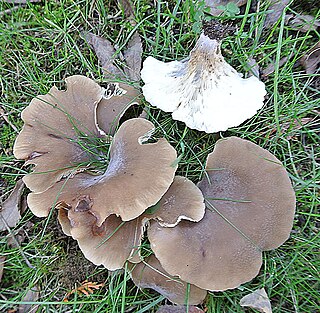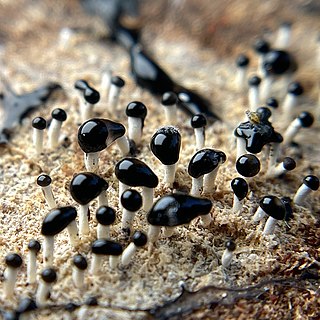
The Agaricales are an order of fungi in the division Basidiomycota. As originally conceived, the order contained all the agarics, but subsequent research has shown that not all agarics are closely related and some belong in other orders, such as the Russulales and Boletales. Conversely, DNA research has also shown that many non-agarics, including some of the clavarioid fungi and gasteroid fungi belong within the Agaricales. The order has 46 extant families, more than 400 genera, and over 25,000 described species, along with six extinct genera known only from the fossil record. Species in the Agaricales range from the familiar Agaricus bisporus and the deadly Amanita virosa to the coral-like Clavaria zollingeri and bracket-like Fistulina hepatica.

Pleurotus eryngii is an edible mushroom native to Mediterranean regions of Europe, the Middle East, and North Africa, but also grown in many parts of Asia.

Pleurotus is a genus of gilled mushrooms which includes one of the most widely eaten mushrooms, P. ostreatus. Species of Pleurotus may be called oyster, abalone, or tree mushrooms, and are some of the most commonly cultivated edible mushrooms in the world. Pleurotus fungi have also been used in mycoremediation of pollutants, such as petroleum and polycyclic aromatic hydrocarbons.

The Agaricomycetes are a class of fungi in the division Basidiomycota. The taxon is roughly identical to that defined for the Homobasidiomycetes by Hibbett & Thorn, with the inclusion of Auriculariales and Sebacinales. It includes not only mushroom-forming fungi, but also most species placed in the deprecated taxa Gasteromycetes and Homobasidiomycetes. Within the subdivision Agaricomycotina, which already excludes the smut and rust fungi, the Agaricomycetes can be further defined by the exclusion of the classes Tremellomycetes and Dacrymycetes, which are generally considered to be jelly fungi. However, a few former "jelly fungi", such as Auricularia, are classified in the Agaricomycetes. According to a 2008 estimate, Agaricomycetes include 17 orders, 100 families, 1147 genera, and about 21000 species. Modern molecular phylogenetic analyses have been since used to help define several new orders in the Agaricomycetes: Amylocorticiales, Jaapiales, Stereopsidales, and Lepidostromatales.

Pleurotus dryinus, commonly known as the veiled oyster mushroom, is a species of fungus in the family Pleurotaceae. It grows on dead wood and is also a weak pathogen; infecting especially broad-leaved trees.

Nematophagous fungi are carnivorous fungi specialized in trapping and digesting nematodes. Around 160 species are known. There exist both species that live inside the nematodes from the beginning and others that catch them, mostly with glue traps or in rings, some of which constrict on contact. Some species possess both types of traps. Another technique is to stun the nematodes using toxins, which is a method employed by Coprinus comatus, Stropharia rugosoannulata, and the family Pleurotaceae. The habit of feeding on nematodes has arisen many times among fungi, as is demonstrated by the fact that nematophagous species are found in all major fungal groups. Nematophagous fungi can be useful in controlling those nematodes that eat crops. Purpureocillium, for example, can be used as a bio-nematicide.

Heliocybe is an agaric genus closely allied to Neolentinus and the bracket fungus, Gloeophyllum, all of which cause brown rot of wood. Heliocybe sulcata, the type and sole species, is characterized by thumb-sized, tough, revivable, often dried, mushroom fruitbodies, with a tanned symmetric pileus that is radially cracked into a cartoon sun-like pattern of arranged scales and ridges, distant serrated lamellae, and a scaly central stipe. Microscopically it differs from Neolentinus by the absence of clamp connections. Like Neolentinus, it produces abundant, conspicuous pleurocystidia. Heliocybe sulcata typically fruits on decorticated, sun-dried and cracked wood, such as fence posts and rails, vineyard trellises in Europe, branches in slash areas, and semi-arid areas such on sagebrush or on naio branches in rain shadow areas of Hawaii, or in open pine forests.

The Inocybaceae are a family of fungi in the order Agaricales, the largest order of mushroom-forming fungi. It is one of the larger families within Agaricales. This family exhibits an ectomycorrhizal ecology. Members of this family have a widespread distribution in tropical and temperate areas.

Panus conchatus, commonly known as the lilac oysterling, smooth panus, or conch panus, is an inedible species of mushroom that occurs throughout the Northern Hemisphere. Its fruitbodies are characterized by a smooth, lilac- or tan-colored cap, and decurrent gills. The fungus is saprophytic and fruits on the decomposing wood of a wide variety of deciduous and coniferous trees. Despite being a gilled species, phylogenetic analysis has shown it is closely related to the pored species found in the family Polyporaceae.

Pleurotus nebrodensis, commonly known as funcia di basilicu "fungus of basilisk" or carduncieddu di macchia "macchia carduncieddu(?)", is a fungus that was declared by the IUCN as critically endangered in 2006. This fungus only grows on limestone in northern Sicily in association with Cachrys ferulacea. The characteristics of the mushroom are its creamy white to yellow colour, its diameter of between 5 and 20 centimeters, its extremely angled gills, and the breaking apart of the cap surface at maturity.

Hohenbuehelia is a pleurotoid genus of agaric fungi characterized by gelatinous-sheathed bowling-pin-shaped cystidia, on conidia, basidiospore germ tubes, and mycelium that adhere to and capture nematodes. The fruitbodies bear thick-walled cystidia (metuloids) in the hymenium along the gill sides and that differentiate the genus from Pleurotus in the Pleurotaceae family. The genus has a widespread distribution and contains about 50 species.
Nematoctonus was a genus of fungi in the Pleurotaceae family, which is now considered a synonym of Hohenbuehelia. Originally the generic name —an anamorphic form of Hohenbuehelia—has a widespread distribution and contains 16 species. Under the one fungus - one name convention, the correct name for the group is Hohenbuehelia and species where the fruitbodies have not been discovered or that are older names for those described as fruitbodies have all been transferred to Hohenbuehelia.

Pleurotus australis, the brown oyster mushroom, is a gilled fungus native to Australia and New Zealand. It is found on dead wood. Although morphologically similar to some other Pleurotus fungi, it has been shown to be a distinct species incapable of cross-breeding.

Pleurotus purpureo-olivaceus is a gilled fungus native to Australia and New Zealand. It is found on dead wood of Nothofagus trees. Although morphologically similar to some other Pleurotus fungi, it has been shown to be a distinct species incapable of cross-breeding and phylogenetically removed from other species of Pleurotus.
Pleurotus tuber-regium, the king tuber mushroom, is an edible gilled fungus native to the tropics, including Africa, Asia, and Australasia. It has been shown to be a distinct species incapable of cross-breeding and phylogenetically removed from other species of Pleurotus.

Gilled fungi with laterally-attached fruiting bodies are said to be pleurotoid. Pleurotoid fungi are typically wood-decay fungi and are found on dead and dying trees and coarse woody debris. The pleurotoid form is polyphyletic, having evolved a number of times within the Basidiomycota. Many species of pleurotoid fungi are commonly referred to as "oyster" mushrooms. Laterally-attached fungi with pores rather than gills are referred to as bracket fungi.

Hohenbuehelia petaloides, commonly known as the leaflike oyster or the shoehorn oyster mushroom, is a species of fungus belonging to the family Pleurotaceae.

Pleurotus cystidiosus, also known as abalone mushroom and maple oyster mushroom, is an edible species of fungus in the family Pleurotaceae, described as new to science by mycologist Orson K. Miller Jr. in 1969. It can be cultivated, with spores and growing kits being available commercially. Antromycopsis macrocarpa is the anamorphic form of this species.

Pleurotus abieticola is an edible species of fungus in the family Pleurotaceae, described as new to science by mycologists R.H. Petersen & K.W. Hughes in 1997. It grows on rotten wood of Picea in subalpine forests dominated by it. It has been reported first in far‐eastern Russia, and then northeastern China and northwestern Russia. It can be cultivated. Phylogenetic research has shown that while it belongs to P. ostreatus clade, it forms its own intersterility group.

Pleurotus parsonsiae, also known as velvet oyster mushroom, is a species of edible fungus in the genus Pleurotus, endemic to New Zealand.


















